OS grid reference SU474643 | Post town NEWBURY Dialling code 01635 | |
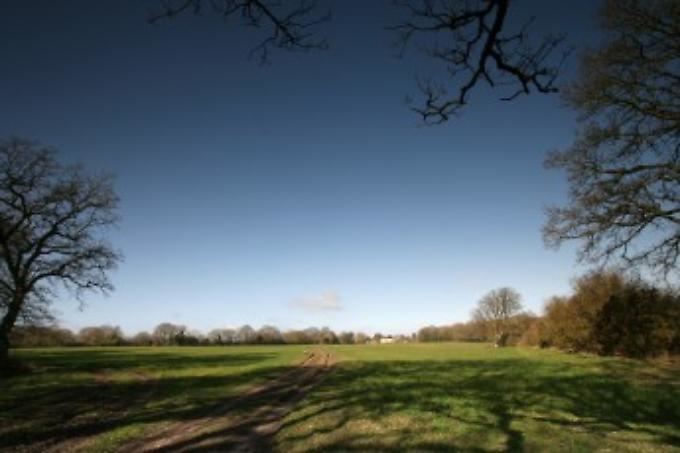 | ||
Bunnings sandleford safe review
Sandleford is a hamlet and former parish in the English county of Berkshire. The settlement is now within the civil parish of Greenham, and is located approximately 1.5 miles (2.4 km) south of the town of Newbury. It measures about 520 acres, most of which is taken up with the fields and copses to the west of the Priory. A census taken in 1801 showed Sandleford to have three houses, three families and 18 people. At the same time Newbury comprised 931 houses, 34 empty houses, 971 families and 4275 people. John Marius Wilson in his Imperial Gazetteer of England and Wales, 1870–72, gave Sandleford as having Real property £775; of which £10 are in fisheries, and a population of 49 in nine houses, but in 1881 the population of Sandleford had shrunk to 34. In 1615 it was separated from the manor and parish of Newbury, and the adjacent Wash Common and became extra-parochial, as described by Sir Francis More, Kt, of Fawley, it was to be: no part of the Parish of Newbury, nor to be so reputed. At some point after 1924 it was subsumed into the parish of Greenham.
Contents
- Bunnings sandleford safe review
- Sandleford Priory
- Sandleford CottageLodgePlace
- Literature
- Sandleford Fair and Festival
- Free Warren
- Notable owners residents and people associated with Sandleford
- Geoffrey and Matilda
- Other typical donors to the priory
- West Ilsley
- Priorys main holdings in 1291
- Kingsclere Woodlands
- Priors of Sandleford
- Robin Hood
- Richard Beauchamp
- Dean and Canons of Windsor
- Dr John Burgess
- Thomas Hide or Hyde
- Sir Francis Moore
- Commonwealth and Protectorate
- Alexander and Thomas Staples
- Kingsmill family
- William Cradock
- Montagu family and associates
- Mary Morgans description
- Matthew Montagu William Wilberforce and Sandleford
- Chatteris and beyond
- Sandleford MillCottageLodgePlace
- Miscellaneous
- Mrs Elizabeth Montagus 1743 description of Sandleford
- William Cobbetts description 1821
- Landscape
- Mrs Montagu and Newbury job creation
- Tourist Attraction
- 1781 survey
- Midgham
- Recent history
- References
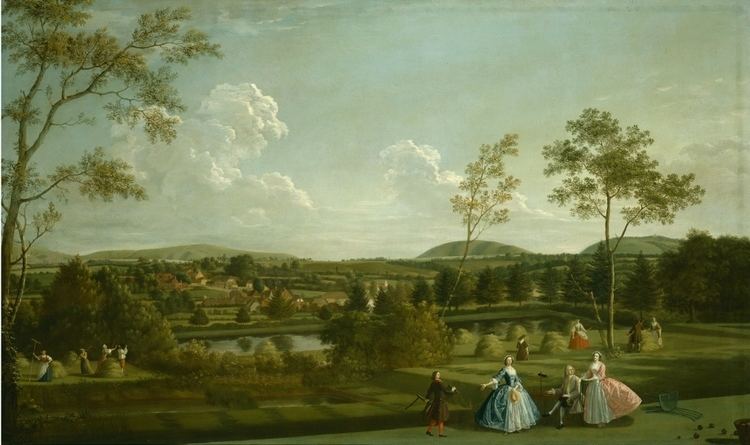
On 23 August 1759 the Rector of Newbury, Rev. Thomas Penrose (died 1769), father of the poet Thomas Penrose, in answer to some set questions about Newbury, and to question number five in particular which concerned 'seats of gentry' in the town, wrote this: [Newbury has] No seat of gentry; if you except Sandleford, which is an estate held of the church of Windsor, and which is often considered as extra-parochial, but which pays a composition in lieu of tithes to the rector of Newbury. It is situated to the south of Newbury. The present lessee is Edward Montagu, Esq.; Member of Parliament for the town of Huntingdon.
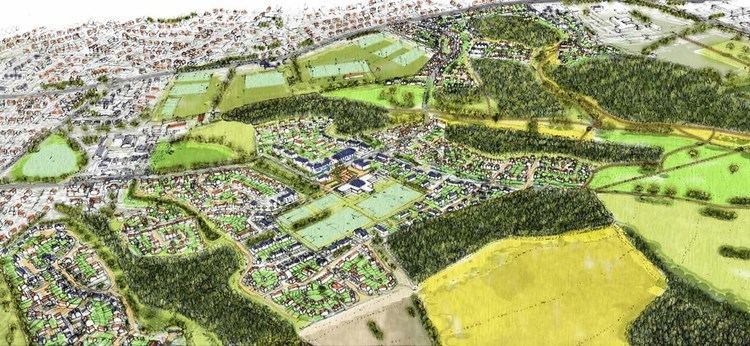
Sandleford Priory
The remains of Sandleford Priory (1200–1478) are incorporated into St Gabriel's School.
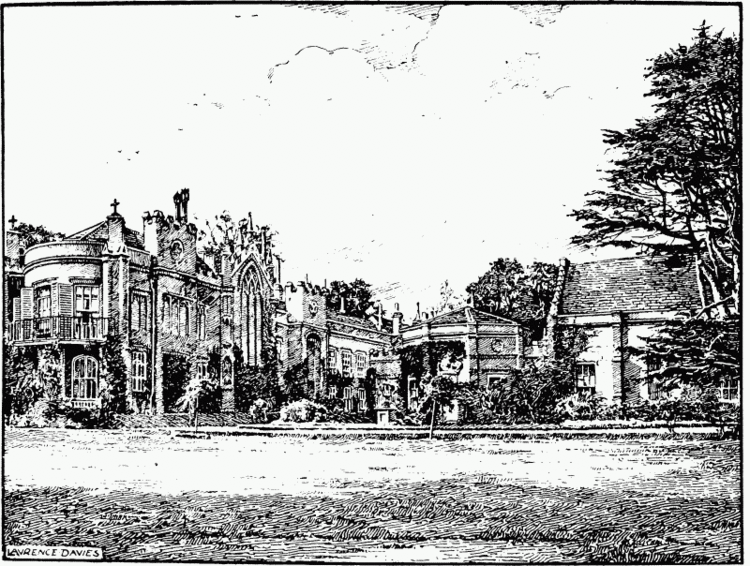
Sandleford was a priory of Austin canons, founded between 1193 and 1202 by Geoffrey, 4th count of Perch, and Richenza-Matilda his wife. A confirmation charter from Archbishop Stephen indicates the priory was dedicated to St John the Baptist and endowed with all the lands of Sandleford. The appropriation of the priory to the Dean and Canons of Windsor was mainly owing to Bishop Beauchamp of Salisbury, who was dean of Windsor from 1478 to 1481. By this time it appears the religious had forsaken the priory.
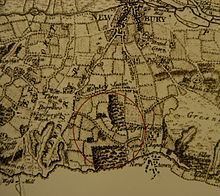
On 9 March 1478, Richard Beauchamp, Bishop of Salisbury and Dean of Windsor, surrendered to the Dean and Canons of Windsor, all the lands, tenements, manors, etc, in Berkshire, formerly belonging to the Prior and Convent of St John the Baptist, Sandleford.
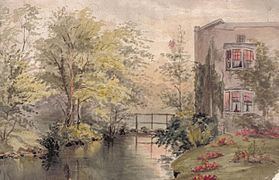
The priory had been richly endowed with properties over a number of years and those which came into the possession of the Dean and Canons included the following: Lands in Bramley, Chiddingfold, and Hambledon, Surrey; the manor of East Enborne, Berkshire; lands in Freefolk, Whitchurch, Hampshire; lands in Kingsclere, Hampshire; lands in Newbury, Berkshire; lands in Newtown, Hampshire; lands in Pamber, Hampshire; the manor of Roke, Odiham, Hampshire; and the rectory of West Ilsley, Berkshire.
The original rhomboid shaped endowment for the Augustinian priory of Sandleford read something like:
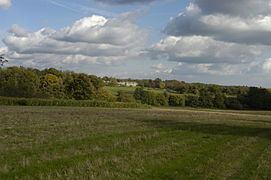
with the church and all the lands at Sandelford [Sandleford, aka Sandaleford : ford of the river Ale-burne], as it is bounded by hedges and ditches [i.e. enclosed] and all its appurtenances, And the whole of the wood which is called Brademore [Broadmore], And the whole of the land on each side of the wood, as it is bounded on one side by the watercourse which is called the Aleburne [River Enborne] from the Bridge of Sandleford up to the Aleburne-gate, and on the other-side as far as it is bounded by the road which reaches from Aleburne-gate towards Newbury as far as the croft of William the Hunter, and on the third side so far as the road is carried, thence to the croft of Robert the son of Renbaldi, [Robert fitz Rembaldand], – that is the road that leads to Newbury, and on the fourth side as it is bounded by the same road [A339] as far as the bridge of Sandleford.
An extract of the original Latin foundation description:
... ecclesiam et totam terram de Sandelford, sicuti sepibus vel fossatis circumsepta est, cum omnibus pertinentiis suis, et totum boscum qui vocatur Brademore, et totam terram ex utraque parte jusdem bosci, sicut cingitur ex una parte acqua quae vocatur Aleburne, a ponte de Sandelford usque ad Alburnegate, et in alia parte sicut cingitur via quae extenditur de Alburnegate versus Nyweburie, usque ad croftam Willielmi Venatoris: ...Sandleford Cottage/Lodge/Place
On the southern boundary, by the River Enborne, on the Berkshire and Hampshire, and Sandleford and Newtown border.
Literature
The original home of the rabbits in Richard Adams' novel Watership Down was at Sandleford.
Mrs. Elizabeth Montagu, the distinguished blue-stocking, who lived at Sandleford from 1742 until her death in 1800 writes from and mentions Sandleford in dozens of her of letters.
Sandleford Fair and Festival
On 1235 the Prior of Sandleford obtained from King Henry III the right to hold a charter fair of four days during the Feast of Saint Matthew the Apostle (21 September), and perhaps another two days around 20–23 September. Suitably enough, 780 years later, the present day Newbury Show, aka Royal County of Berkshire Show, is held over those days. Perhaps one is the successor of the other, afteral the first annual Newbury and District Agricultural Show was held in 1909 on land included in the Priory's original 1190s endowment at Enborne Gate Farm, aka Alburnegate.
Free Warren
In 1293, King Edward I granted the priory free warren on all its demesne lands at Sandleford and Enborne; so long as nevertheless those lands are not within the bounds of our forest. (Note that forest does not mean woods).
Notable owners, residents, and people associated with Sandleford
From secluded holy women (inclusae), naughty priors (Simon Dam) with illicit mistresses (Thomasina), via the Blue-stocking pioneer (Elizabeth Montagu) to the present day where one of the co-absentee-landowners is husband of a Russian princess and father a star of Made in Chelsea, the rulers Sandleford have been a illustrious bunch.
Geoffrey and Matilda
Other typical donors to the priory
West Ilsley
Further described in an Inspeximus, dated 1251–1256.
Priory's main holdings in 1291
The taxation roll of Pope Nicholas IV in 1291 names temporalities (secular properties and possessions) that the prior of Sandleford held, which were worth (per annum):
Kingsclere Woodlands
In 1312 Prior Thomas de Sandleford obtained a licence for alienation in mortmain to this convent of a messuage, 20 acres of land, and 2 acres of meadow in 'Clere Wodelond,' by Kingsclere, Hampshire.
Priors of Sandleford
Robin Hood
One of the Henry III rolls of Easter 1262, reads:
Rex mandavit baronibus de scaccario per breve quod perdonavit priori de Sandelford' j marcam as quam amerciatus fuit coram Gilbert de Preston' et sociis suis justicariis ultimo itinerantibus in Comitatu Berk' pro eo quod idem prior seisivit sine waranto catalla Willelmi Robehod' fugitivi, et ideo quod ipsum inde quietus esse faciant.Richard Beauchamp
Dean and Canons of Windsor
Dr. John Burgess
A draft lease of the site of Sandleford Priory dated 30 September 1543 reads: Draft for a lease from William Frankeleyn, Dean, and the Canons of Windsor, to John Burges, of London, Doctor in Physick, of their place of Sandylford [Sandleford], in the County of Berks, for forty years at a rental of £10. A later muniment, 'Estimate of farm' was entitled: View or estimate of the farm of the priory of Sandylford [Sandleford], and of the free Chapel and Chantry there, with a declaration of the grant of the Dean and Canons of the King's free Chapel of Windsor lately made to John Burges, doctor in phisic, etc. Burgess who died in 1550, had an AM Oxon (1530–1), MB (1533–4), MD, and was admitted a Fellow of the Royal College of Physicians (FRCP) in 1536, was elected Censor and Elect, 1543; Consiliarius, 1544, 1545, 1546; and President, 1547. William Munk says that 'Dr. Burgess was dead on 30 March 1550, when his place of Elect was filled by the appointment of Dr. Caius' .
Thomas Hide or Hyde
A lease dated 11 October 1560 of the site of Sandleford Priory was named: Lease to Thomas Hide of Hurst, in the County of Barks, gentleman, for 6 years for £15, all the scite of the pryarye of Sandylforde [Sandleford] near unto Newberye [Newbury], in the County of Barks., signed Thomas Hyde. A later Thomas Hide (Hyde) of Hurst, Berkshire (died 1652), was son of William Hyde (c.1517–67), MP, and grandson of William Hyde (high sheriff) of the family Hide of Dentchworth.
Sir Francis Moore
Commonwealth and Protectorate
In October 1642, Colonel John Venn and twelve companies of foot soldiers took possession of Windsor Castle on behalf of Parliament, and soon after 23 May 1643 the Dean (Dr. Christopher Wren) and Canons left. On 17 October 1650 Sandleford and the estates that had come to the Dean and Canons of Windsor via Sandleford would have been included in an Act for sale of the Manors of Rectories and Glebelands late belonging to the late Archbishops, bishops, Deans, Deans and Chapters was passed, and in an Additional Act for more speedy effecting the sale of the Manors of Rectories and Glebe-lands late belonging to Archbishops, Bishops, Deans, Deans and Chapters, and other Officers and Titles which late were of or belonging to any Cathedral or Collegiate Church or Chapel in England or Wales; and for the encouragement of lenders upon the security thereof; and of other Lands and Hereditaments of the said Deans, Deans and Chapters, etc. which was added on 22 October 1650.
Alexander and Thomas Staples
A quitclaim dated 20 May 1662 states: Alexander Staples of the Middle Temple and Thomas Staples of the same for £200 paid by the Dean and Canons renounce and give a quittance of all their rights in Sandleford Priory. The scite of Sandelford Priory was by the trustees appointed by act of Parliament, 20 June 1651, sold to Thomas Bales of the Middle Temple, and he 25 February sold the same to Alexander Staples, and he settled it on Thomas Staples and his heirs.
Alexander Staples, son of Alexander Staples of Yate Court, Gloucestershire, (died 1590) by his second wife Elizabeth, was Mayor of Nottingham in 1629, and heir of the bulk of his estate of his 'kinsman' Alderman Robert Staples (died 1632), of Nottingham and Mapperley, cordwainer, Freeman of Nottingham, MP for Nottingham in 1615, and Lord Mayor of Nottingham in 1601, 1608, 1615 and 1622. Alexander Staples' youngest brother is presumed to have been Sir Thomas Staples, 1st Baronet (died 1653), of Lissan House, admitted to Middle Temple on 27 May 1606 and who left Bristol for Ulster c.1610.
Thomas Staples of Maidenhead, was named as the Steward of Windsor Court in the case of Vasper & wife v [James] East, 1685. One of the judges was George Jeffreys, 1st Baron Jeffreys and at the time Henry, Earl of Arundel & Lord Mowbray was Constable of Windsor Castle.
By January 1689/90 however, Thomas Staples was proving to make the Oath to the new King. The House of Lords Journal, Volume 14, for 22 January 1689 reports that: Staples, Steward of Windsor, sent for, for refusing to give the Oaths. Upon Information given to this House, 'That Mr. Thomas Staples, Steward of Windsor Forrest, hath refused to give the Oaths of Allegiance and Supremacy and the Test to Mr. Charles Cleve Master of the Hospital of Oakingham, and Mr. William Walker Vicar of Sunning: It is thereupon ORDERED, by the Lords Spiritual and Temporal assembled at Westminster, That the said Thomas Staples be, and is hereby, required to attend this House on Friday next, being the 25th Day of this Instant January, at Ten of the Clock in the Forenoon, as he will answer the contrary to this House at his Peril.'
And on 'DIE Veneris, 25 die Januarii.' Staple's Examination about refusing to tender the Oaths deferred. The House being moved, 'That Mr. Thomas Staples, Steward of Windsor Court, who, by Order of the 22th [sic] Instant, was to appear this Day, attended at the Door; but not being able to get his Witnesses ready against this Day, might have longer Time given him for that Purpose:' It is ORDERED, by the Lords Spiritual and Temporal assembled at Westm. That the said Thomas Staples be, and is hereby, required to attend this House on Friday the 8th Day of February next, at Ten of the Clock in the Forenoon.
Kingsmill family
Three generations of the Kingsmill family of Sydmonton leased Sandleford between 1626 and circa 1715. Bridget Colt, Margaret Woodward (Lady Woodard [sic] seem to have been the lessee between Sir Henry Colt and Humphrey Forster), and Anne Forster, three of the seven daughters of Sir William Kingsmill, kt, (died 1618), by his wife Ann Wilkes, were followed by their nephew John, and then finally his son Henry.
William Cradock
Montagu family and associates
In a letter to one of her brothers, dated Sandleford, 9 June 1777, Mrs Montagu wrote about her agricultural relationship with Sandleford.
Mary Morgan's description
...I felt myself sufficiently gratified, that a great portion of genius is possessed by my sex; I was entirely devoid of dread or envy. After driving twenty miles through a very pleasant country, and through the pretty town of Newbury, we entered Mrs. Montagu's park, which seemed to have undergone some recent improvements, as the trees were many of them newly planted. The approach to the house is a fine lawn, with sheep feeding upon it. This gives you the idea of beauty blended with utility, which always produces agreeable sensations in the mind...
...In this wing is an elegant dressing-room above stairs. This too has a large bow, on the outside of which there is a very spacious balcony, surrounded by iron balustrades. The balcony commands a distant view of the Hampshire hills, and an extensive diversified country. The small village of Newton in the Valley has an humble simplicity in it, that is agreeably contrasted with the lofty hills beyond it...
...When we withdrew to go to bed, we were ushered up stairs by the major domo, with a wax light in each hand. I found the bedroom lighted up, and a female waiting in it ready to undress me. Mrs M.-- was not conducted into my room, but into a dressing-room adjoining, by a door that opened into a passage. Reflecting on this, to me unusual ceremony, I almost began to fancy myself a bride again; or else, that I was transported into some fairy region, where I was to be waited upon by spirits, that were every where attending without being called for...
...In the dressing-room there was a collection of books; amongst them I found your friend Miss Cornelia Knight's Dinarbas. Here you may amuse yourself in the morning, if you please, till dinner calls you again to society.
The grounds are laid out with the same Attic taste, as the house. Through a great part of them Mrs. Montagu has trained a river, which was little more than a ditch; and means to extend it still further... she has likewise cut a winding path through her plantations. It is a carriage way and is a mile in length. It is also a very pleasant walk, and may serve; 'or for study, or for love' being perfectly secluded. At agreeable distances are benches under the shadow of a large tree, or the shelter of a close hedge interwoven with woodbines and honeysuckles.
When walking in the grounds, I observed an extraordinary degree of cleanliness and decency in the men, who were at work in them. Upon enquiry I found they were all fed and cloathed by her hand. I perceived too that many of them had some great defect, occasioned by age, natural infirmity, or misfortune, being either blind, deaf, dumb, or lame; yet she so paired them, and fitted their employments to their several faculties, that the remaining senses of one served to supply the deficiencies of the other. By this stroke of benevolent ingenuity, though she does not get so much work done, as she would by stronger and abler men; she has the heart-felt satisfaction of making those useful and happy members of society, whom nobody else would employ, and who, but for her, must be dependent upon a parish for an idle and scanty substance. I hope it is not prophane to say, she has made the blind to see, the deaf to hear, the dumb to speak, and the lame to walk. The whole of this place suggested to me the idea of a Roman villa. There is every thing for use as well as beauty. The farm and dairy are not omitted; they supply the family and table with all things necessary and delicate. In short, there is a style in every part of it, that bespeaks a superior degree of judgment. Nothing is gaudy or superfluous, yet nothing is wanting. Native genius, matured by observation upon what is simply elegant, has guided the hand of the amiable possessor of this enchanting place... Adieu.
A few days later she continued: (To Miss B., Letter IX, Woodstock, 16 July 1791): Having before described Sandleford to you, I cannot help observing, that it is a striking contrast to Blenheim. But it is such a one, as when the eye, dazzled with gazing at the sun, falls on the soft green of a beautiful lawn, upon which it may rest for ever without satiety or weariness. At Sandleford the mind is gratified with everything that can render life rational and happy. At Blenheim it is fatigued with contemplating objects, that seem like a golden dream, too gay and too gaudy to be real.
Morgan's list of subscribers shows that Elizabeth Montagu, aka Montagu, Mrs. Portman Square-10 copies., and her nephew (the son of Rev. William Robinson, rector of Burghfield), aka Robinson, Rev. Mr. Rector of Coveney, in the Isle of Ely-6 copies., evidently appreciated this ebullient description.
Matthew Montagu, William Wilberforce, and Sandleford
Montagu was a friend and supporter of William Wilberforce, and thus favoured the abolition of the slave trade. Wilberforce, stayed at Sandleford, 27–28 July 1789:
27th. Set off for Bath and reached Sandleford. The old lady [Elizabeth Montagu] wonderfully spirited, are all very kind in their reception. 28th. Almost compelled to stay with the Montagus all day. Mrs. Montagu senior has many fine, and great, and amiable qualities. Young Montagu all gratitude and respect and affection to her and of most upright and pure intentions.Wilberforce was at Sandleford one night in July 1791:
Monday 28 July. Off betimes on Sierra Leone business-reached Sandleford (M. Montagu's) in the evening. Dr. Beattie was already arrived.Chatteris and beyond
At the time of the 1851 census Chatteris and his wife lived in the priory with an indoor staff of 12; butler, footman, under-butler, housekeeper, lady's maid, cook, laundry maid, three house maids, kitchen maid, and a scullery maid. One of his sisters, Eliza (died 1866), had married Edmund Arbuthnot (1793–1873) of Newtown in 1824, Sandlefords's closest village, which would have been Chatteris' introduction to the area as he took on the lease of Sandleford in 1835. His first wife (married 1833) was Anne (died 1848) eldest daughter of Rt Rev Alexander Arbuthnot, DD, Bishop of Killaloe (1768–1828), and his brother-law Edmund's first cousin. He planted a world-class azalea and rhododendron garden. He died at Sandleford Priory leaving £155,141, his executors were his former half-brother-in-law Sir Charles George Arbuthnot, GCB, (1824 –1899), and the Rev. Frances Charles Gosling, vicar in charge of Newtown, 1859–1900. Another half-brother-in-law Sir Alexander John Arbuthnot, KCSI CIE (1822–1907) lived at nearby Newtown house;
At the time of the 1911 census Sandleford Priory was inhabited by two males and 14 females. Henrietta Myers (aged 79), her surviving daughter Henrietta Constance Myers (44), and a cook-housekeeper (66), two lady's maids (64 & 48), two laundry maids (20 & 38), three house maids (24, 24, & 22), kitchen maid (26), scullery maid (20), and two footmen (23 & 20).
Sandleford Mill/Cottage/Lodge/Place
Miscellaneous
Mrs Elizabeth Montagu's 1743 description of Sandleford
In 1743 Mrs Montagu wrote from Sandleford to her old friend the Duchess of Portland and described her new retreat:
'...I had a very pleasant journey to this place, where I am delighted to find everything that is capable of making retreat agreeable; the garden commands a fine prospect, the most cheerful I ever saw, and not of shirt distance which is only to gratify the pride of seeing, but such as falls within the humble reach of my eyes. We have a pretty village [ Newtown ] on a rising ground just before us.'
Where the cottage chimney smokes,
Fast between two oaks.
'Poverty here is clad in its decent garb of low simplicity, but her tattered robes of misery do not here show want and wretchedness; you would rather imagine pomp was neglected than sufficiency wanted.'
'A silver stream [the Alder stream, aka river Enborne] washes the foot of the village; health, pleasure, and refreshment are the ingredients that qualify this spring; no debauch, or intoxication, arises from its source.'
'Nature has been very indulgent to this country, and has given it enough of wood and water; the first we have here in good plenty, and a power of having more of the latter, as improvements are undertaken.'
'Here are temptations to riding and walking. I go out every evening to take a view of the country; the villages are the neatest I ever saw; every cottage is tight; has a little garden, and is sheltered by fine trees...'
William Cobbett's description, 1821
The Radical MP and journalist William Cobbett (1762–1835) wrote about Sandleford in his journal whilst staying with the farmer Mr. Budd at Burghclere, on 30 October 1821. Appropriately 150 years later Budd's Farm was home to the writer Roger Mortimer. This is the gist of it:
'...Came through a place called "a park" belonging to a Mr. Montague, who is now abroad ;Of all the ridiculous things I ever saw in my life this place is the most ridiculous. The house looks like a sort of church, in somewhat of a gothic style of building, with crosses on the tops of different parts of the pile. There is a sort of swamp, at the foot of a wood, at no great distance from the front of the house'.'...Here is a fountain, the basin of which is not four feet over, and the water spout not exceeding the pour from a tea-pot. Here is a bridge over a river of which a child four years old would clear the banks at a jump...''...In short, such fooleries I never before beheld; but what I disliked most was the apparent impiety of a part of these works of refined taste'.'...I wonder how long this sickly, this childish, taste is to remain?''..At the end of this scene of mock grandeur and mock antiquity I found something more rational; namely, some hare hounds, and, in half-an-hour after, we found, and I had the first hare-hunt that I had had since I wore a smock-frock !'Landscape
The priory of Sandleford's foundation diploma or charter (circa 1194) describes in Latin the scope of the site and lands of the priory:
'Geoffrey count of the Perche and Countess Matilda endow the Augustinian priory of Sandleford (Berkshire) with the church and all the land at Sandleford, together with the wood known as Brademore [Broadmore] and with all the land on both sides of that wood that is, bounded by the watercourse known as Aleburn [river Enborne] from the bridge at Sandleford to the Alburnegate, then by the road which runs from Alburnegate towards Newbury up to the croft of William the huntsman [Wash Common] and on the third side from there along the road [Monks Lane] to the croft of Robert fitz Rembaldand [Robert son of Rembaldi] on the fourth side [A339] up to the bridge at Sandleford. The right to build a mill is granted together with an annual sum of thirteen marks of sterling to be taken from the mills of Newbury every four weeks. When the prior dies one of the remaining canons is to be chosen in his place, 1194–1202.'
A typical lease, this one dated 6 May 1668, granted by the Dean and Canons of Windsor to John Kingsmill of Sandleford, scite of the Priory etc all lately in tenure of Humphrey Fo[r]ster of Aldermaston, in the County of Berks, Bart, and John Harrison of Lincoln's Inn for 21 years at £15 2s. for fishing AND Lease of Sandleford coppices, called Bradmore and Highwood, the first late held by Anthony Childe and the other by Richard Pinfold, and their coppices in the Parish of Migham, in all 68 acres, by the Dean and Canons of Windsor to John Kingsmill of Sandelford, esquire.
Another later but similar lease of the estate, this one dated 31 August 1737, between Edward Montagu and the Dean and Canons of Windsor in summary read: Lease of the scite of the Priory, the farm of Sandelford [Sandleford], and Tydhams [Tydehams] and all messuages, tenements in Sandelford and Midgham, Berks, in Burrowghcleere [Burghclere] and Sidmanton [Sydmonton], in the county of Hants, the meadow called Milmead on the South side of Aborn Streame [River Enborne], (except woods and the tenement which John Dean occupies in Sandelford near Abornstream and an acre of land on its north side, and Waterleaze and a piece of Sandelford green 3 acres and certain rights of fishing in Aborn stream) – and also fishing in the river Kennett in the parishes Limborn [Lambourn], Enborne and Nubery [Newbury], by the Dean and Canons of Windsor to Edward Mountague of London, esquire.
If approached and seen from the south, from the Newtown Common or Whitchurch road, the distant prospect of Sandleford, with steep, magnificent and south facing parkland and wooded slopes with the priory itself sitting atop, high, the effect would have been like that of Camelot or Shangdu. The Xandu of Samuel Purchas, as in his 1614 description based on what Marco Polo had reported: In Xandu did Cublai Can build a stately Pallace, encompassing sixteen miles of plaine ground with a wall, wherein are fertile Meddowes, pleasant Springs, delightfull streames, and all sorts of beasts of chase and game, and in the middest thereof a sumpuous house of pleasure, which may be moved from place to place.
The parish of Sandleford is, as mentioned above, about 500 acres, most of which is an arcadian farm and woodland that lies to the west of the priory/school. This almost square block is bounded by the River Enborne to the south; on the west by a hedge line that runs two furlongs to the east of the Andover Road (A343) which runs north-south through Wash Common; Monks (Monkey) Lane and therefore Newbury to the north (though the parish boundary runs a bit south of the road); and the Newtown road, A339 (previously A34) to the east (though clearly parish boundary and the priory/school is to the east of that).
Almost the only way into this park is from the west, from the A343, Andover road, past the Roman Catholic church at Warren Lodge, and down the remaining 200 yards of an ancient track flanked by field maple, oak, ash, hazel, ivy, elm, elder, hawthorn, and blackthorn. Around here the cavalry of Prince Rupert of the Rhine lined up before the First Battle of Newbury in September 1643, and near here are the meadows which feature in the beginning of Richard Adams' semi-factual novel Watership Down. At this point the enclosed track ends at the Newbury (Wash Common)/Sandleford parish boundary, but the public footpath or former carriage track continues. In previous centuries, in Mrs. Montagu's day, this was the main route to the priory from the west, from places like Bath, Somerset. Here the view quickly opens out, expansively, perspective tricks have been played with hedge and wood edge lines which add to the sense of infinity and space.
Barn copse is passed on the left or north. A hedge line connects Barn Copse to Dirty Ground Copse, and another hedge line from that forms an arrow with the northern edge of Gorse Covert. Comparison of the 1761 John Rocque map with how things now appear suggests a degree of highly clever tweeking of wood and hedge lines to maximise the effect of the landscape took place in the late eighteenth century. In the far distance on the right, to the south, there is Sidown Hill with its brick folly Heaven's Gate, built in 1749 for Hon. Robert Sawyer Herbert (1693–1769), MP (for Wilton 1722–1768), of Highclere, second son of Thomas Herbert, 8th Earl of Pembroke, visible at about 60 feet high, and next to that Beacon Hill.
As the track passes through the bottle-neck formed by this hedge and the north-east end of Gorse Covert the viewer then goes through to the next instalment, a first distant prospect of Sandleford Priory itself, and the North Downs, including Watership Down.
The track continues due east passing High Wood and a distant view of Slockett's Copse and Crook's Copse beyond to the left or north. Eventually the track reaches the A339 and the main entrance to the priory/school. Through the heart of this block of 500 acres a small stream runs north south from the top of Crook's Copse, down between High Wood and Slockett's Copse and then having been joined by another smaller stream runs east parallel with the southern edge of High Wood and then turns south again towards the River Enborne.
In 1749 Elizabeth Montagu wrote to her husband from Tunbridge Wells: My Dearest, ... I flatter myself the Captain will think Berkshire not inferior to Surry [sic], especially if he bestrides his Arabian steed, and surveys the prospects from Newbury Wash, Greenham &c. When he is tired of mere cows and sheep, and would behold some of those fair creatures, Father Philip's geese,...
Mrs. Montagu's views on landscape, indicating that parks and gardens should be under the care of the cherub Contemplation, are somewhat revealed in a letter to Gilbert West, dated 1753, 25th:
'I suppose you have been at Stowe, where art has exhausted all her powers,'
Equel, che il bello, o il caro accresce all' opre
L'arte, che tutto fa, nulla si Scopre
'Such, I am told, is its present state; when I saw the gardens they brought not so much to one's imagination the scenes of paradise, as of that garden, where the sapient king with his fair spouse held dalliance; it is rather a retreat for the proud and victorious, than the philosophic mind; like the poets, it was an Elysian only for heroes; ambition found examples there, and restless emulation fair incitements, but no quiet scenes hushed the passions into peace, and excluded the visions of this world's vanities; which, I take to be the great benefit of the retreat which should put the mind into the guardian care of the cherub Contemplation.'
In September 1757 Mrs Montagu wrote to Dr. Messenger Monsey (1693–1788), FRS, ... I assure you we have Groves too at Sandleford, where you may meet your Amante Sposa, Dame Melancholy, as often as you please....
Mrs Montagu and Newbury job creation
In July 1782 Mrs Montagu mentioned the high unemployment then found in Newbury and the works going on at Sandleford: The scene is extremely animated; 20 men at work in the wood and grove, and the fields around are full of haymakers. The persons employed on the work are poor weavers who by the decay of our manufacture at Newbury are void of employment, and not having been trained to the business of agriculture are not dexterous at the rake and pitchfork, but the plain digging and driving wheel barrows they can perform and are very glad to get their daily subsistence.
Tourist Attraction
In a letter dated Deal, 21 July 1786, Elizabeth Carter wrote to her friend Elizabeth Montagu: 'Your letter, my dear friend, ... The trouble which you receive from the curiosity of people to see your improvements at Sandleford, is one of the natural embarras des richesses. Nobody plagues me by besieging my doors in carriages, and upon pillions to see my cottage. After all, however, it is very strange how people can be so impertinent, one would think they might at least suspend their impatient curiosity till you were absent'.
A year later Elizabeth Carter, in a letter, dated Deal, 22 June 1787, pointed to the music of the groves: ' ... By this time, my dear friend, I hope you are enjoying the music of your groves at Sandleford... '.
1781 survey
A survey of the 619 acre, 2 roods and 17 perches estate made for Mrs Montagu in 1781, by John Spyers (c1720-1798) on behalf of Lancelot Brown, and used when the lease of 503 acres and 111 acres was sold to William Chatteris on 3 November 1835, shows that in 1835 111 acres were owned outright by the Lord Rokeby on the east side (mostly in the parish of Greenham), that 87 acres on the east side belonged to the Dean and Canons of Windsor (held by Lord Rokeby), and that 416 acres on the west side of the road (also leased from the Dean and Canons of Windsor by Lord Rokeby), with 5 acres belonging to Mrs Colman near the mill. One question regarding this 1781 survey is whether it was a depiction of what work was to be done, as conceived by Lancelot Brown, or more likely exactly how the estate was at the time? Meanwhile, the 1871 map shows the landscape as it might have been embellished by Brown, especially regarding the ponds near Broadmoor and Waterleaze woods. It is also possible that this 1871 map was based on a lost map made by Brown as a result of works undertaken after that 1781 survey.
In November 1762 replying to a letter from her husband Mrs Montagu wrote:You are very good in consulting me about the Trees..., which suggests that landscape works had been going on post the Rocque map of 1761 and preceding Capability Brown's involvement post 1781, more in a style as seen at Studley Royal/Fountains Abbey or as painted by people like Jacob van Ruisdael, Antonie Waterloo (1609–1690), or Thomas Gainsborough (1727–1788).
87 acres of coppices on the west side (acres, roods, perches)
60 acres of meadowland on the west side (acres, roods, perches)
227 and 40 acres of arable on the west side (acres, roods, perches)
and
The 16 acres field known as Fulwars was no doubt named after Fulwar Craven, 4th Baron Craven (1704–1764), of nearby Benham Park and Hampstead Marshall, High Steward of Newbury 1739–1764, and a founder of the Craven hunt. The 1781 survey map also shows the Montagu purchases of coppices (such as Little Peckmore and Collin's coppices) and water-meadows at Peckmore and on the north side of the Auborn stream (alias river Enborne), and its layout before its severe disturbance by the new west-east running A339; re-routed along the river Enborne as a result of two of the old roads to Newbury that formerly crossed Greenham Common south-north being severed when the airport was made circa 1942. The map also shows a Rick yard; farm yard, with a very large barn; the Green yard in front of the priory; a Wilderness walk; and a Bowling green. The map shows the stream that flows south into the river Enborne (aka Auborne stream) which also marked the border of the parishes of Greenham and Sandleford and was to provide the water that formed what is known as Brown's (extant), Woodhouse (derelict), and Newtown ponds (seems to have disappeared). Collin's coppice ran just east of the priory's demesne, near where the first ponds were formed. Collin's coppice still exists at the south-western corner of Greenham Common, as does Peckmoor, an arable field now a grazed part of Bunker farm.
Midgham
The priory of Sandleford held land in nearby Midgham. In the 13th century this was assessed as one carucate (normally 120 acres). There were still 37 acres of meadow there that had been leased to those who also leased Sandleford. This connection was mentioned down to the end of the eighteenth century, by when the meadow land was let to members of the Hillersdon, and Poyntz families of Midgham House, viz: William Poyntz (died 1809), John Spencer, 1st Earl Spencer of Althorpe (son-in-law of Stephen Poyntz), Rt. Hon. Stephen Poyntz, and John Hillersdon (died 1730). One of the younger sons of George II, Duke of Cumberland (1721–1765), was partially bought up at Midgham in the household of his governor and steward Stephen Poyntz.
Recent history
On 30 September 1986, the circa 470 acre Sandleford Farm, was sold by Neate's, with help from Knight Frank & Rutley, at the Chequers Hotel, Newbury, for over two million pounds. In the meantime the 1972 writings of Richard Adams in chapter one of Watership Down regarding the borders of Wash Common and Sandleford (what Adams calls Sandleford Common) seem rather prescient concerning the ambitious and imminent housing plans that have since abounded.
Suddenly Fiver shivered and cowered down.'Oh, Hazel! This is where it comes from! I know now –something very bad! Some terrible thing – coming closerand closer'.He began to whimper with fear.'What sort of thing-what do you mean?I thought yousaid there was no danger?''I don't know what it is,' answered Fiver wretchedly.'There isn't any danger here at this moment. But it'scoming – it's coming. Oh, Hazel, look! The field! It'scovered with blood!'...'Back to the burrow?' whimpered Fiver. 'It'll comethere – don't think it won't! I tell you, the field's full ofblood -'...... ...THIS IDEALLY SITUATED ESTATE, COM-PRISING SIX ACRES OF EXCELLENTBUILDING LAND, IS TO BE DEVELOPEDWITH HIGH CLASS MODERN RESIDENCESBY SUTCH AND MARTIN, LIMITED, OFNEWBURY, BERKS.